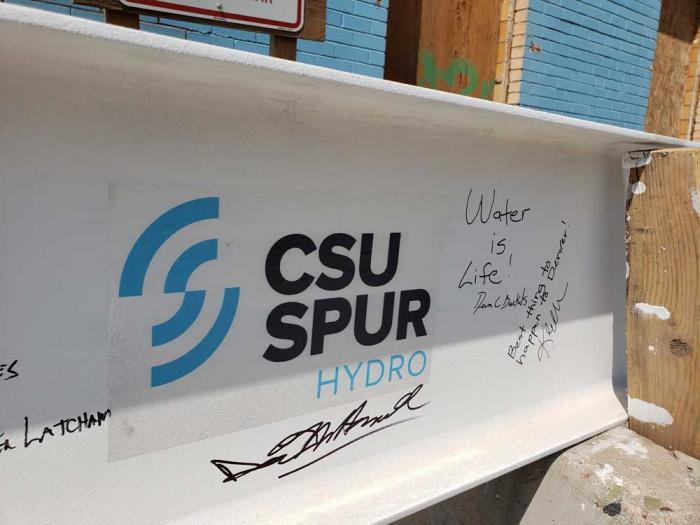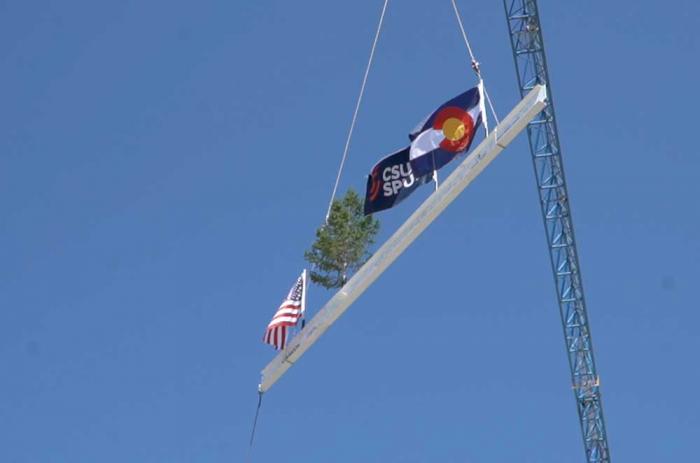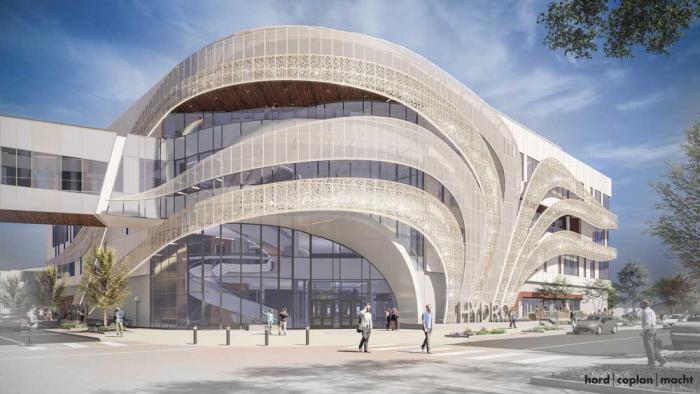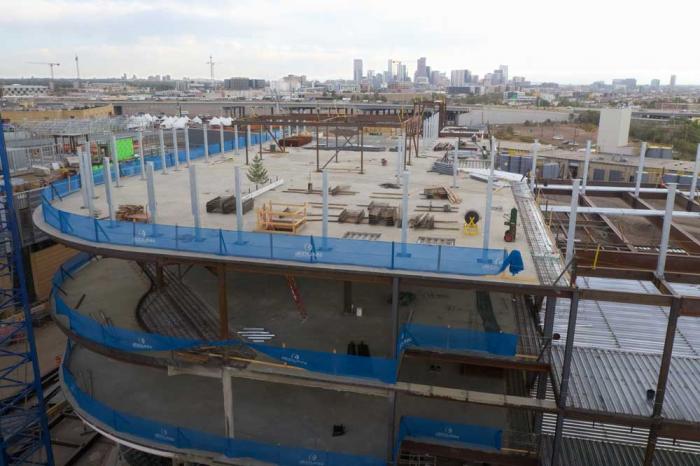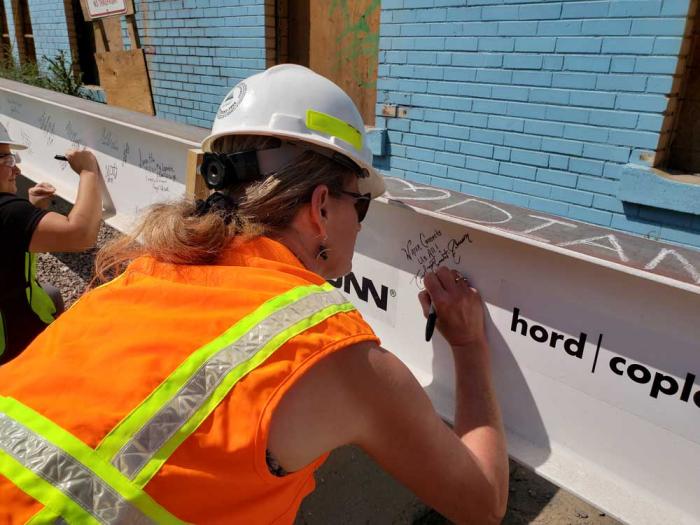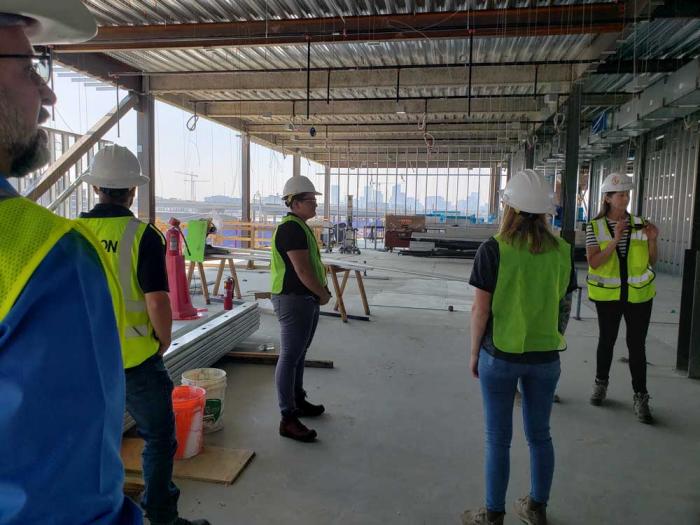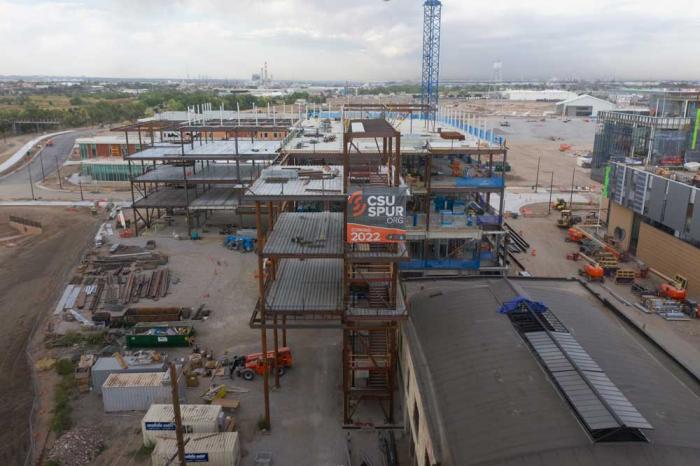Hydro building at National Western Center passes milestone
Gently swaying from cables attached to a giant crane, a steel beam in mid-September was lifted into place atop the new Hydro building at the National Western Center, with a crowd cheering below and cloudless blue skies above.
The topping out ceremony on Sept. 16 marked the placement of the final steel beam on the Hydro building, one of three new buildings under construction on Colorado State University's Spur campus at the old stock show complex, which is being redeveloped.
The moment also celebrated a major milestone in the yearslong partnership between Denver Water and CSU.
When the Hydro building is done in November 2022, the third floor of the 122,000-square-foot building will be home to Denver Water’s new water quality laboratory.
“Denver Water is very excited to be part of this amazing facility and opportunity with CSU Spur, giving us a closer connection with the public and the 1.5 million people we serve,” said Tom Roode, chief operations and maintenance officer for Denver Water.
“This puts us right in the heart of a new research environment, in a spot where we can work far more closely and readily with academics and other innovators studying a wide spectrum of emerging and current water quality issues and solutions to ensure we can continue to deliver safe, reliable, great-tasting water to the Denver metro area not only today, but also well into the future.”
The CSU Spur campus also includes the Vida building, which will open in January 2022 and is focused on public health, and the Terra building, scheduled to open in April 2022 and focused on land and agriculture.
“This beautiful building, when Hydro is complete, will have an exterior that evokes a river eddy — the place on the river where the water slows and mixes,” Jocelyn Hittle, CSU’s assistant vice chancellor for CSU Spur, said as the beam rose into place.
“That’s a metaphor for what will happen in this building and on this campus. We’ll bring people together from different disciplines — students, researchers, scientists and entrepreneurs — to talk, to mix together, to solve problems and innovate around water, agriculture and other big issues facing the state.”
With the move to the Hydro building, Denver Water’s lab will emerge from an obscure setting, tucked away behind security gates near the Marston Treatment Plant in southwest Denver, to settle into a more central location near the junction of Interstate 70 and I-25.
The new location will make it easier for Denver Water employees to bring water samples from across the utility’s system, said Fred Sanchez, manager of water quality operations at Denver Water.
“We collect thousands of water samples throughout the year — from the forests to the customer’s faucet, from our 4,000 square miles of watershed up in the mountains through the treatment plants and across the distribution system — and all those samples will come to the new lab for testing and analysis,” Sanchez said.
The lab will continue its crucial role in ensuring the water that Denver Water delivers to 1.5 million people across the metro area is clean and safe.
And the new location means the lab will have the space and flexibility needed to grow and handle nearly three times the number of tests the existing lab conducts every year, said Nicole Poncelet-Johnson, the head of water quality and treatment at Denver Water.
Plus, she said, the Hydro building’s proximity to researchers working in the Terra and Vida buildings opens up new possibilities for collaboration and research on issues vital to Colorado’s future.
“We’re in a prime spot — with our lab and our people — to be part of the growth of knowledge around water and its use in agriculture and in public health,” Poncelet-Johnson said.
“We live in a dry, arid region that’s not getting any wetter. So we want to participate in research that will help us understand how we can help farmers, the public and our customers thrive through the changes we’ll experience in the next several decades.”
The Spur campus also is near several pieces of the metro area’s water infrastructure: the South Platte River, which is being cleaned and rehabilitated; the region’s major wastewater treatment facility operated by the Metro Wastewater Reclamation District (which changed its name to Metro Water Recovery in September 2021); and Denver Water’s own recycled water treatment plant.
And the National Western Center will use water in other innovative ways, too.
Nearly 90% of the heating and cooling needs on the 250-acre center will come from what is otherwise unused thermal energy in an underground sewer pipeline. The innovative project is expected to be the largest sewer-heat recovery system in the North America.
“The quality of the water — knowing what it is, how it changes, and how it affects our food and our lives — is a central part of so much of the work that will happen at the site, and it just makes sense that our laboratory is here and we can help,” Poncelet-Johnson said.
“If you look back at Denver Water’s history, they planned and made really smart decisions 100 years ago that allowed us to build an infrastructure that supports 1.5 million people. It’s our job to do the same for the next 100 years, to develop the research on how to use our resources wisely to support future generations.”


